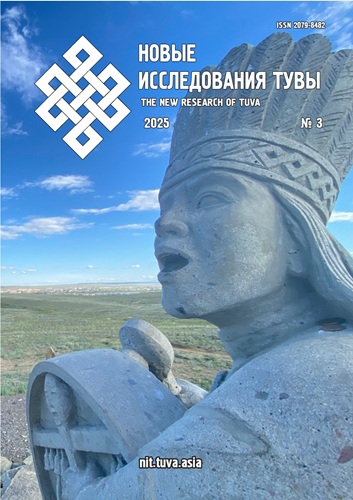The Status of Nomadic Families in Tuva and Features of Their Adaptation to Contemporary Conditions
DOI:
https://doi.org/10.25178/nit.2025.3.14Keywords:
nomadic lifestyle; livestock breeding; shepherd; Tuvan family; nomadic family; Internet access; TuvansAbstract
The article analyzes the issues of adaptation of modern nomadic Tuvan families to the changing socio-economic conditions of life in Tuva. The analysis is based on the results of a sociological survey conducted among representatives of nomadic families in 2025.
The changes in the size of the social group of shepherds and reindeer herders in Tuva are examined. During the post-Soviet period, a decline in the number of shepherds as both a social and professional group occurred, which correspondingly reduced the number of nomadic families within the structure of Tuvan society. Special support programs for livestock breeders adopted by the republican authorities helped modify this trend, albeit insignificantly, partly because these programs were not specifically targeted at the needs of families. The absence of state support programs for nomadic families in Tuva is noted.
Structural changes occurring within Tuvan nomadic families are shown. Several factors (such as children’s education, financial difficulties) lead to the practice of spouses living separately (with the family’s seasonal camp on the one hand and the village or town on the other). The education system obliges children to live far from their parents’ household, thereby disrupting the continuity of traditional family succession. Parents themselves are inclined to have their children obtain professional education and move to other locations. Problems with access to communication networks and digital technologies also cause difficulties in the existence of nomadic families. All these factors complicate the livelihood of nomadic families.
References
Baisheva, S. M. (2014) Everyday life of national settlements of Yakutia in the context of sociological studies. Arktika i Sever, no. 14, pp. 83–97. (In Russ.)
Bulgan, B. and Enkhtuya, T. (2021) Current situation of children of nomadic Mongolian pastoral families living in dormitories. In: Primary General Education: Issues of Development, Methodological and Staffing Support. Proceedings of the III All-Russian Scientific-Methodical Conference with International Participation, Irkutsk, 23 October 2020, edited by M. A. Petrova, L. V. Kalinina, B. V. Gusevskaya and S. A. Konogorskaya. Irkutsk, Irkutsk State University. 281 p. Pp. 247–254. (In Russ.)
Vinokurova, T. S., Sannikova, Y. M., Suleymanov, A. A., Filippova, V. V. and Grigoryev, S. A. (2019) Indigenous communities of the Russian Arctic in the 20th century: power and nomads of Yakutia. Nauchny dialog, no. 2, pp. 188–203. (In Russ.) DOI: https://doi.org/10.24224/2227-1295-2019-2-188-203
Zheleznyakov, A. S. (2009) Nomadic civilization: dead end or development prospects. Izvestiya vysshikh uchebnykh zavedeniy. Sotsiologiya. Ekonomika. Politika, no. 2, pp. 58–60. (In Russ.)
Zhukovskaya, I. M. (2025) Seasonal nomadic group of short-term residence as a form of preschool education provision for children leading a traditional lifestyle jointly with parents. Kochevoe obrazovanie: aktualnye voprosy, dostizheniya i perspektivy razvitiya, no. 1, pp. 15–18. (In Russ.) DOI: https://doi.org/10.24412/cl-37296-2025-1-15-18
Karlov, V. V. (2016) Nomads in the world of modernity and postmodernity. Experience and prospects of adaptation. Siberian Historical Research, no. 4, pp. 131–153. (In Russ.) DOI: https://doi.org/10.17223/2312461X/14/7
Konstantinova, T. N. (2014) Changes in family forms in the North: regional measurements. Teoriya i praktika obshchestvennogo razvitiya, no. 7, pp. 27–31. (In Russ.)
Konstantinova, T. N. (2015) Transformation of lifestyle of northern families: social adaptation to changing conditions. Russian Journal of Education and Psychology, no. 6, no. 50, pp. 666–677. (In Russ.) DOI: https://doi.org/10.12731/2218-7405-2015-6-56
Kradin, N. N. (2024) The East and the world-historical process. Trudy instituta istorii, arkheologii i etnografii DVO RAN , vol. 44, pp. 53–77. (In Russ.) DOI: https://doi.org/10.24412/2658-5960-2024-44-53-77
Lamazhaa, Ch. K. (2021) Children for Tuvans: changes in attitude in sociocultural transformations. New Research of Tuva, no. 4, pp. 57–75. (In Russ.) DOI: https://doi.org/10.25178/nit.2021.4.5
Natsak, O. D. (2021) Features of gender asymmetry in the modern Tuvan family. Bulletin of Kalmyk Scientific Center of RAS, no. 2, pp. 120–143. (In Russ.) DOI: https://doi.org/10.22162/2587-6503-2021-2-18-120-143
Natsak, O. D. (2022a) Gender division of household labor in Tuvan families. Vektory blagopoluchiya: ekonomika i sotciyum, no. 1 (144), pp. 79–90. (In Russ.) DOI: https://doi.org/10.18799/26584956/2022/1/1144
Natsak, O. D. (2022b) Distribution of gender power in the modern Tuvan family. Teoriya i praktika obshchestvennogo razvitiya , no. 2, pp. 28–36. (In Russ.) DOI: https://doi.org/10.24158/tipor.2022.2.3
Neustroev, N. D. and Neustroeva, A. N. (2017) Nomadic school as a mobile form of school network under northern conditions. Vestnik Severo-Vostochnogo federalnogo universiteta , no. 3 (07), pp. 7–13. (In Russ.)
Novikova, N. I. (2024) Anthropologization of law (using the example of laws on indigenous small-numbered peoples of the North). Sibirskiye istoricheskiye issledovaniya, no. 4, pp. 59–77. (In Russ.)
Potapov, L. P. (1969) Essays on the folk way of life of Tuvans. Moscow, Nauka. 402 p. (In Russ.)
Samarina, N. G. (2011) Nomadic livestock breeding and sedentism of Tuvans in the Soviet period. Vestnik Tomskogo gosudarstvennogo universiteta, no. 4 (16), pp. 123–126. (In Russ.)
Social Stratification Processes in the Republic of Tuva (2020) / Z. T. Golenkova et al.; ed. Z. T. Golenkova, Yu. V. Goliusova and P. E. Sushko. Moscow, Kyzyl, Federal Research Sociological Center, Russian Academy of Sciences. 128 p. (In Russ.) DOI: https://doi.org/10.19181/monogr.978-5-89697-332-4.2020
Rostovskaya, T. K., Natsak, O. D., Yagodka, N. N. and Elamanova, A. S. (2024) Modern studies of the Tuvan family: problem-thematic and methodological analysis. New Research of Tuva, no. 4, pp. 238–258. (In Russ.) DOI: https://doi.org/10.25178/nit.2024.4.16
Sosin, V. V. (2021) On improving the legislation of the Republic of Sakha (Yakutia) in the field of preservation and support of nomadic families. Arktika-2035: aktualnye voprosy, problemy, resheniya, no. 3 (7), pp. 19–28. (In Russ.) DOI: https://doi.org/10.51823/74670_2021_3_19
Strygina, S. V. (2023) Law and socioecosystem of small indigenous peoples of the North of the Russian Federation: theoretical and legal analysis of the social phenomena relationship. Izvestiya Saratovskogo universiteta. Novaya seriya. Seriya: Ekonomika. Upravlenie. Pravo, vol. 23, no. 2, pp. 219–226. (In Russ.) DOI: https://doi.org/10.18500/1994-2540-2023-23-2-219-226
Tarbastaeva, I. S. (2024) Rural-urban interaction in Tuva (based on interviews with natives of Ovursky district). New Research of Tuva, no. 2, pp. 209–224. (In Russ.) DOI: https://doi.org/10.25178/nit.2024.2.13
Fedorova, N. R. and Nikolaeva, L. V. (2020) On the problem of organizing nomadic preschool educational organization in the Arctic conditions. Sovremennye naukoemkie tekhnologii, no. 11–1, pp. 219–223. (In Russ.) DOI: https://doi.org/10.17513/snt.38366
Enkhtuvshin, B. (2015) Nomads and Nomadism. Traditions and modernity. Izvestiya Irkutskoy gosudarstvennoy ekonomicheskoy akademii, vol. 25, no. 4, pp. 691–699. (In Russ.)
Humphrey, C. and Sneath, D. (2006) The End of Nomadism? Ulaanbaatar, Inter Press. 368 p. (In Mongolian)
Khilazheva, G. F. (2021) The modern family in the context of translocal migration (on the example of shift-work migrant families in Bashkortostan). Zhenshchina v rossiyskom obshchestve, no. 1, pp. 68–82. (In Russ.) DOI: https://doi.org/10.21064/WinRS.2021.1.6
Published
How to Cite
For citation:
Rostovskaya T. K., Natsak O. D. and Delovarova L. F. The Status of Nomadic Families in Tuva and Features of Their Adaptation to Contemporary Conditions. New Research of Tuva, 2025, no. 3, pp. 212-233. (In Russ.). DOI: https://doi.org/10.25178/nit.2025.3.14
Issue
Section

This work is licensed under a Creative Commons Attribution-NonCommercial 4.0 International License.

Author(s) license holder(s) grant rights for their work to the journal (grantee of a license) under the simple non-exclusive open license in accordance with Art. 1286.1 «Open license for a research work, work of literature or fine arts», Civil Code of the Russian Federation.
New Research of Tuva publishes articles under the Creative Commons Attribution-NonCommercial license (CC BY-NC).
Since it is an open license, author(s) reserve the right to upload the article to their institutional repository, submit it to another journal (if it allows republications), or republish it on their own website (in full, or in part).
However, several conditions apply here:
a) The republished version must always contain the name(s) and affiliation(s) of the author(s), the original title and the hyperlink to the original version on the New Research of Tuva website;
b) It must be in open access, free of charge, and no category of readers must be in any way whatsoever advantaged over general readership.
c) should the contribution be submitted elsewhere by its author(s) without substantial modification (30% or more of original text unchanged), the body of the article should contain a disclaimer that the original version was published in New Research of Tuva (with a link to the respective page)
The CC-BY-NC is a non-revocable license which applies worldwide and lasts for the duration of the work’s copyright.











